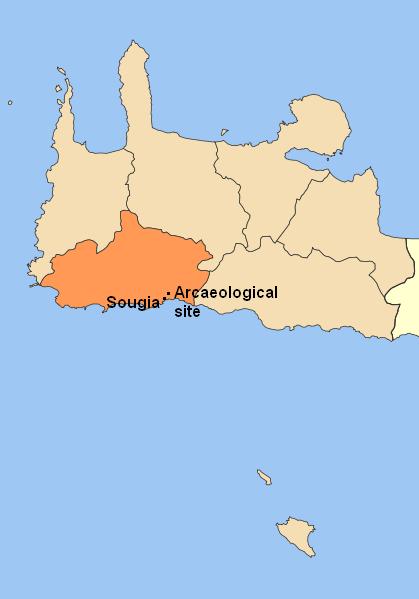Syia on:
[Wikipedia]
[Google]
[Amazon]
 Syia or Suia (), also Syba (Σύβα),''
Syia or Suia (), also Syba (Σύβα),''
Sougia Basilika Ruins.jpg,
Sougia - 01.jpg, Modern day
Populated places in ancient Crete
Former populated places in Greece
Port settlements in ancient Crete
Ancient Greek archaeological sites in Crete
{{AncientCrete-geo-stub
Stadiasmus Maris Magni
The ''Stadiasmus Maris Magni'' or ''Stadiasmus sive Periplus Maris Magni'' () is an ancient Roman periplus or guidebook detailing the ports sailors encounter on the shores of the Mediterranean Sea. The ''stadiasmus'' provides distances, sailing ...
'' §§ 321-322. was a maritime town of ancient Crete
The history of Crete goes back to the 7th millennium BC, preceding the ancient Minoan civilization by more than four millennia. The Minoan civilization was the first civilization in Europe.
During the Iron Age, Crete developed an Ancient Greece-i ...
. It was located on the south coast of Crete and functioned as the harbour of Elyrus
Elyrus or Elyros () was a town of ancient Crete, which the ''Periplus of Pseudo-Scylax'' places between Cydonia and Lissus. It had a harbour, Syia (Συΐα), situated on the south coast of the island, 60 stadia west of Poecilassus.''Stadiasm ...
. According to the ''Stadiasmus Maris Magni
The ''Stadiasmus Maris Magni'' or ''Stadiasmus sive Periplus Maris Magni'' () is an ancient Roman periplus or guidebook detailing the ports sailors encounter on the shores of the Mediterranean Sea. The ''stadiasmus'' provides distances, sailing ...
'', written during Roman times, the town was located 50 stadia to the west of Poecilassus, situated on a plain. It probably existed as late as the time of Hierocles (6th century), though now entirely uninhabited.
It is located in Sougia
Sougia () is a community and a small village in Chania regional unit on the island of Crete, Greece. It is part of the municipal unit of East Selino (''Anatoliko Selino''). It is located on the south coast of the island, 70 km south of Chan ...
village, 70 km south of Chania
Chania (, , ), also sometimes romanization of Greek, romanized as Hania, is a city in Greece and the capital of the Chania (regional unit), Chania regional unit. It lies along the north west coast of the island Crete, about west of Rethymno ...
.
Archaeology
Robert Pashley
Robert Pashley (4 September 1805 – 29 May 1859) was a 19th-century English traveller, lawyer and economist.
Pashley was born in York and he studied at Trinity College, Cambridge. Distinguished in mathematics and Classics, in 1830 he was elected ...
, visiting in the 19th century, found remains of the city walls as well as other public buildings, but not more ancient than the time of the Roman Empire
The Roman Empire ruled the Mediterranean and much of Europe, Western Asia and North Africa. The Roman people, Romans conquered most of this during the Roman Republic, Republic, and it was ruled by emperors following Octavian's assumption of ...
. Several tombs were found, as was an aqueduct.Robert Pashley
Robert Pashley (4 September 1805 – 29 May 1859) was a 19th-century English traveller, lawyer and economist.
Pashley was born in York and he studied at Trinity College, Cambridge. Distinguished in mathematics and Classics, in 1830 he was elected ...
, ''Travels'', vol. ii. p. 100.
Syia flourished in the Roman and the 1st Byzantine period. There are Roman ruins and three large Palaiochristian Basilicas. Syia had set up monetary union with Yrtakina Hyrtacina or Hyrtakina (), also written as Hyrsacina or Hyrsakina (Ὑρσακίνα),''Periplus of Pseudo-Scylax'' p. 18. or Artacina or Artakina (Ἀρτάκινα), was a city of ancient Crete, which, little as we learn of its position from Ptole ...
, Elyrus
Elyrus or Elyros () was a town of ancient Crete, which the ''Periplus of Pseudo-Scylax'' places between Cydonia and Lissus. It had a harbour, Syia (Συΐα), situated on the south coast of the island, 60 stadia west of Poecilassus.''Stadiasm ...
, Lissus, and Tarrha
Tarrha or Tarra (), also Tarrhus or Tarros (Τάρρος), was a ''polis'' (city-state) in the southwestern part of ancient Crete, near the Samaria Gorge, at the village of Agia Roumeli. It is situated near the sea, on the hill.
History
Tarrha w ...
. The city also participated in the Koinon
''Koinon'' (, pl. Κοινά, ''Koina''), meaning "common thing", in the sense of "public", had many applications, some societal, some governmental. An abstract noun formed from the neuter of the adjective, koinos, "common", the koinon could mean ...
of the Oreians. It seems that the Saracen
upright 1.5, Late 15th-century German woodcut depicting Saracens
''Saracen'' ( ) was a term used both in Greek and Latin writings between the 5th and 15th centuries to refer to the people who lived in and near what was designated by the Rom ...
s destroyed the city.
References
Sougia
Sougia () is a community and a small village in Chania regional unit on the island of Crete, Greece. It is part of the municipal unit of East Selino (''Anatoliko Selino''). It is located on the south coast of the island, 70 km south of Chan ...
Sougia - 02.jpg, Modern day Sougia
Sougia () is a community and a small village in Chania regional unit on the island of Crete, Greece. It is part of the municipal unit of East Selino (''Anatoliko Selino''). It is located on the south coast of the island, 70 km south of Chan ...